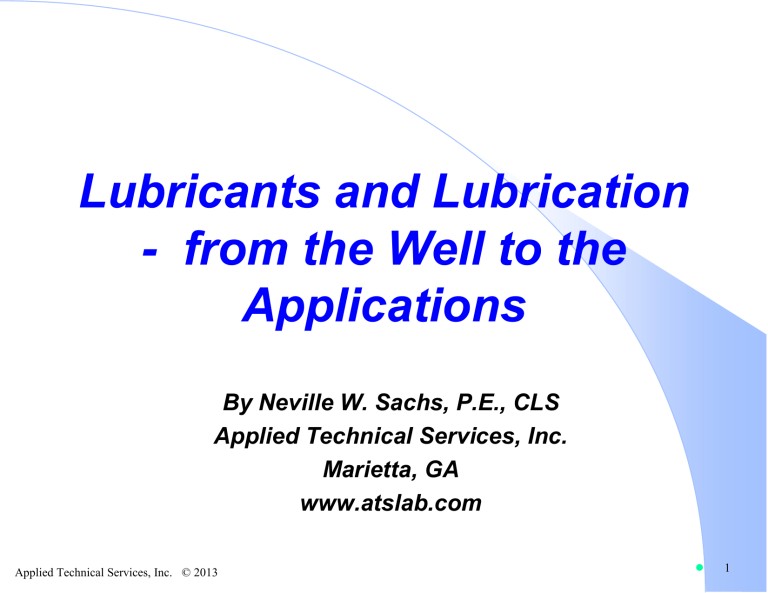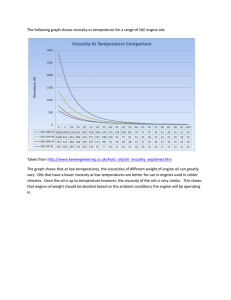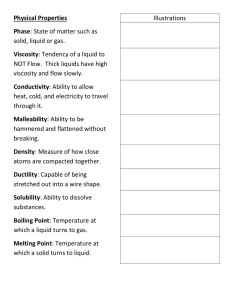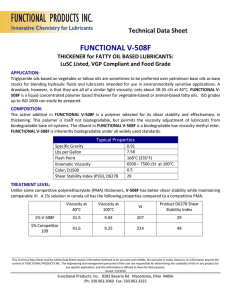
Lubricants and Lubrication - from the Well to the Applications By Neville W. Sachs, P.E., CLS Applied Technical Services, Inc. Marietta, GA www.atslab.com Applied Technical Services, Inc. © 2013 1 Our Plan A little bit about the lubricants industry Explain the basics of how lubricants work in different applications Discuss the important lubricant properties and additives Explain what problems occur with lubricant applications. Applied Technical Services, Inc. © 2013 2 Quiz questions!!!!! 1. Define “viscosity index”. 2. About what percentage of all lubricants is used in cars and light trucks? 3. As the type of bearing rolling element changes, what is the effect on the required viscosity for high speed lubrication? 4. What are the mechanisms that allow “EP” additives to reduce component wear? 5. What effect would solid “EP” additives have on rolling element bearings running at 600 rpm? 6. What effect would solid “EP” additives have on rolling element bearings running at 6 rpm? 7. What are some differences between PCMO oils and turbine oils? Applied Technical Services, Inc. © 2013 3 Conventional Crude Oil Distilled at the refinery in a “fractionating tower” – Lighter oils come off at low temperatures – Heavier oils need higher temperatures Applied Technical Services, Inc. © 2013 4 Production from a Barrel of Crude Oil Gasoline Diesel, Kerosene, and Home Heating Oil Gases (Methane, propane, etc.) Heavy oils (Road oils, Bunker C, etc.) Petrochemical feedstocks Lubricants Coke, etc Less than 1% of the barrel Source – US Department of Energy Applied Technical Services, Inc. © 2013 5 Production from a Barrel of Crude Oil Gasoline Diesel, Kerosene, and Home Heating Oil Gases (Methane, propane, etc.) Heavy oils (Road oils, Bunker C, etc.) Petrochemical feedstocks Lubricants Coke, etc Less than 1% of the barrel From this, we can see that the lubrication world is a very small part of the overall refining business! Source – US Department of Energy Applied Technical Services, Inc. © 2013 6 Where does that production go? Usage US Worldwide Industrial 51 41 Automotive 47 56 Greases 2 3 The US Refinery Production for 2013 was about 60,000,000 barrels 60,000,000 barrels x 42 gallons/barrel = 2.5 billion gallons Applied Technical Services, Inc. © 2013 7 How are lubricants used? Category US World - wide Industrial 51 41 Automotive 47 56 Greases 2 3 PCMO’s US World Applied Technical Services, Inc. © 2013 PCMO = Passenger Car Motor Oils 8 When we look at the industrial usages we see Industrial Engines Process MWO General Industrial Lubrication Applied Technical Services, Inc. © 2013 Category % Process Oils 45 General Industrial Lubricating Oils 27 Metalworking Oils 12 Industrial Engine Oils 16 9 But when we look at Automotive Lubricants … Category ATF Multigrade Engine 83 Oils (PCMO)’s ATF and Hydraulic Fluids PCMO Applied Technical Services, Inc. © 2013 % 15 Other Automotive ≈2 Oils 10 Automotive Lubricants ATF Ind Eng MWO PCMO Process Gen’l Industrial Unfortunately for those of us primarily involved with industrial applications, automotive lubricants are at about 50% of the total lubricants market, and engine oils are over 80% of that, so guess what drives most lubricant research! Applied Technical Services, Inc. © 2013 11 Conventional Mineral Oil Distilled at the refinery in a “fractionating tower” – Lighter oils come off at low temperatures – Heavier oils need higher temperatures Synthetic Oils That depends Some are made from distilled crude that undergoes additional procession Some are truly synthesized from gases and other chemicals (PAO, PAG, etc.) Applied Technical Services, Inc. © 2013 12 What is “viscosity” and how is it defined regarding automotive oils? Viscosity is a measure of a liquid’s resistance to shear, i.e., a measure of how readily the liquid flows. The viscosity of an industrial oil is usually specified at 400C (1040F) while automotive oils are specified at both -180C and 1000C Applied Technical Services, Inc. © 2013 13 Viscosity vs. Temperature -20 0 20 60 80 100 120 2000 Honey 9300 4650 2317 1000 500 927 463 232 200 100 20 10 100 50 59 5 2 32 Antifreeze -50 Applied Technical Services, Inc. © 2013 0 50 100 Temperature (F) 150 200 Viscosity Viscosity - Saybolt Seconds 40 Centistokes -40 Temperature (C) 250 14 Viscosity vs. Temperature SAE 20W-20 engine oil with viscosity spec’d at both -180 and 1000C Temperature (C) 0 20 Range for SAE 20W-20 40 60 80 100 120 2000 Honey 1000 500 927 463 232 200 100 20 10 100 50 59 5 2 32 Antifreeze -50 Applied Technical Services, Inc. © 2013 0 50 100 Temperature (F) 150 200 Viscosity Viscosity - Saybolt Seconds 9300 4650 2317 -20 Centistokes -40 250 15 A viscosity experiment Applied Technical Services, Inc. © 2013 16 How are the typical viscosity ranges defined regarding industrial oils? The viscosity of an industrial oil is usually specified at 400C (1040F). However different formulations may result in two oils that have identical viscosities at 400C, but very different viscosities at another temperature, e.g., -170C (00F) This difference in the rate of change is because the two oils have different “viscosity indexes” (VI’s). Applied Technical Services, Inc. © 2013 17 Understanding the Viscosity Index Temperature – 0C 0 20 40 60 80 100 120 Honey 2000 1000 500 95 Viscosity – Centistokes (cSt) VI = 300 100 40 100 20 15 70 10 6 50 Antifreeze 4 40 -50 Applied Technical Services, Inc. © 2013 -20 0 Viscosity – Saybolt Seconds (SSU) -40 = VI ISO Standards call for the viscosity 50000 0 of oils to be rated at 40 C. But, 10000 as the temperature increases, some oils become much more 2000 1000 fluid than others. These oils that 500 “thin” more rapidly have a lower viscosity index. 200 0 50 100 150 Temperature – 0F 200 250 18 Viscosity Index Temperature – 0C -40 -20 0 20 40 60 80 100 120 Pennsylvania 90-100 North Sea 55-70 West Texas 45 -60 North Slope (Alaska) 10-30 California 0-20 Applied Technical Services, Inc. © 2013 VI = 2000 1000 500 2000 1000 500 95 Viscosity – Centistokes (cSt) Typical Viscosity Index Range 10000 0 Crude Source Honey = VI The chart below shows the viscosity index for some common crude oil sources. Viscosity – Saybolt Seconds (SSU) 50000 300 100 200 40 100 20 15 70 10 6 50 Antifreeze 4 40 -50 0 50 100 150 Temperature – 0F 200 250 19 Viscosity Index – from another view. Notice the huge difference at higher temperatures. Temperature – 0C -40 -20 0 20 40 80 60 100 120 Pennsylvania 90-100 North Sea 55-70 West Texas 45 -60 North Slope (Alaska) 10-30 California 0-20 Applied Technical Services, Inc. © 2013 300 0 Typical Viscosity Index Range 2000 1000 500 2000 1000 500 = VI Crude Source Honey 10000 100 VI = 200 40 95 100 20 15 70 10 6 50 Antifreeze 4 40 -50 0 50 Viscosity – Centistokes (cSt) The chart below shows the viscosity index for some common crude oil sources. Viscosity – Saybolt Seconds (SSU) 50000 100 150 Temperature – 0F 200 250 20 Back to Automotive Engine Oils We’ll look at engine oils, comparing a 20W-20 with a “multi-viscosity” 20W – 50 [The “W” indicates the viscosity at 00F (-180C)] Applied Technical Services, Inc. © 2013 21 Viscosity vs. Temperature with a typical multi-viscosity engine oil 0 20 Range for SAE 20 40 60 80 100 120 2000 Honey 1000 500 SAE 20W-50 927 463 232 200 100 SAE 20W-20 50 100 20 10 59 5 2 32 Antifreeze -50 Applied Technical Services, Inc. © 2013 0 50 100 Temperature (F) 150 200 Viscosity Viscosity - Saybolt Seconds 9300 4650 2317 -20 Centistokes -40 Temperature (C) 250 22 Oil and Grease Additives Viscosity Index Improvers Detergents and Dispersants Pour Point Depressants Emulsifiers and Demulsifiers Rust and Corrosion Inhibitors Extreme Pressure Additives Oxidation Inhibitors Antifoam Agents Antiwear Compounds Friction Modifiers Depending on the application, different base oils and the compatible additives are selected. Applied Technical Services, Inc. © 2013 23 Where additives are used AW or EP Corrosion Inhibitor Automotive engine oils xx xx xx xx xx xx xx ATF xx xx xx xx xx xx xx Industrial gear oils xx x x xx xx xx Hydraulic fluids xx x x xx xx xx Turbine oils xx xx x Metalworking fluids xx xx x Greases xx Lubricant Oxidation Inhibitor VI Improver Pour Point depressan tEmulsifier/ Demulsifie rDefoamer Detergent/ Dispersant Additives x x x xx xx x x xx xx x “xx” indicates an additive is essentially always used “x” indicates an additive is sometimes used Applied Technical Services, Inc. © 2013 24 Let’s look at the different additives on the handout Applied Technical Services, Inc. © 2013 25 Oil and Grease Additives Lubricants are a combination of the base oil and the additives and the specific combination depends on the properties of both. Examples: Gear oils need antiwear or EP additives. Turbine oils need good demulsibility while wheel bearing greases need emulsibility. Oils that operate over a wide temperature range need VI improvers. Hydraulic oils need antiwear additives but rarely need EP additives. Applied Technical Services, Inc. © 2013 26 How does a Lubricant Prevent Wear? Part One Surface Ratio of the two dimensions = λ Part Two Surface This sketch shows a greatly magnified view of two parts separated by a lubricant film. The separation is important because the greater the distance, the less the parts contact each other and less wear occurs. The Greek symbol lambda, λ, is usually used to denote the relative film thickness. λ is a result of the viscosity, relative speed, and the shape (relative roughness) of the parts. Applied Technical Services, Inc. © 2013 27 vs. Wear Rates in Normal Operation Wear Rate General Lubrication Regimes Mixed – (ElastohydroDynamic) Hydrodynamic Boundary (sliding) (full film) Relative Film Thickness This graph shows how important the lubricant film thickness is in controlling the wear rate. Viscosity is most important on the right side of the graph while the key to reducing friction on the left side is the additive film. Applied Technical Services, Inc. © 2013 28 Friction changes with conditions Stribeck Curve Coefficient of Friction 0.2 Boundary Friction Zone Mixed Film Zone Full Film Fluid Friction Zone 0.002 Viscosity x Speed/ Load Applied Technical Services, Inc. © 2013 29 The Three Basic Bearing Configurations • • • Sliding Bearings – and lowspeed plain bearings usually use boundary lubrication Plain Bearings - with oil they use hydrodynamic lubrication (but grease bearings can use boundary films). Rolling Element Bearings using elastohydrodynamic (mixed) lubrication Combinations - moderate speed gears or low speed bearings Applied Technical Services, Inc. © 2013 Wear Rate • Wear Rates and Film Thickness Mixed – (ElastohydroDynamic) Hydrodynamic Boundary (sliding) (full film) Relative Film Thickness 30 Rolling Element Bearings Load Ball and Roller Bearings - in general industrial equipment Travel Pressures - As high as 300,000 psi in the load zone Element Clearance - In the range of 0.00002” Lubricant to 0.00004” Exit Region Inlet Most Important Lubricant Properties - Viscosity, Cleanliness Hertzian Fatigue Zone (Film thickness ≈ 0.00004”) Action - Inlet zone viscosity transformation supports clearance Applied Technical Services, Inc. © 2013 31 How Pressure Affects Viscosity Absolute viscosity (cP) Pressure – Viscosity Relationship for a light Mineral Oil ASME Research Committee on Lubrication – Volume 11 (1953) 100000 10000 Honey 1000 100 10 Antifreeze 0 20 40 60 80 100 120 140 Pressure (1000 psi) Applied Technical Services, Inc. © 2013 32 Plain Bearings Oil Feed Bearing Bore Oil Film Thickness Shaft Journal Positive Film Pressure Applied Technical Services, Inc. © 2013 Applications - Automotive engines, large motors, generators Pressures - In heavy duty diesels can range as high as 3500 psi (170kPa). Film Thickness - 0.0005 to 0.002” (12 to 50 µm), depending on conditions Most Important Lubricant Properties - Viscosity, contaminants smaller than film thickness Action - Viscosity of oil swept into load zone develops pressure film 33 Discovering How Plain Bearings Work 600 500 3 400 1 300 200 100 Center Oil Pressure (psi) Center Oil Film Shaft Journal Positive Film Pressure Outgoing (3) Incoming (1) 0 3 1 This sketch is from Beauchamp Tower’s original report on his experiments to understand how plain bearings work and shows the pressure in a 4” diam x 6” long journal. Kingsbury’s experiments on similar devices showed the friction coefficient to be 0.0005. Applied Technical Services, Inc. © 2013 34 Sliding Bearing Operation Pressures - Up to yield strength stresses on the mating parts. Important Lubricant Properties - Film Motion One part forming additives, solid particle additives. Two very different classes of Additives AW - Low stress antiwear lubricants Other part usually use fatty acids to separate pieces Motion EP - High stress extreme pressure applications have two systems. Contact between opposing plates Magnified View causes chemical action and additives form a solid lubricant film, reducing Lube friction between plates. Film Solid additives, like MoS2 or graphite, act as separators. Applied Technical Services, Inc. © 2013 35 Sliding Bearing Operation Low stress AntiWear lubricants usually use fatty acids to separate pieces (problems above 1500C) Fatty Acids (Polar molecules) High stress Extreme Pressure applications usually combine two systems: Contact between opposing plates causes a chemical action and additives form a solid lubricant film, reducing friction. Solid additives, like MoS2 or graphite, that act as separators. Magnified Views of Surfaces with EP Lubricants Chemical Reaction Additives Solid Separating Additives Sliding Plates Wear Resistant Compounds Applied Technical Services, Inc. © 2013 36 Basics of Selecting a Lubricant (1 page) st What is the application? What type of action does it have to perform? What is the operating atmosphere? What are the contaminants and how severe are they? Is metal-to-metal contact likely? Are additives needed? In noise level important? Applied Technical Services, Inc. © 2013 37 Basics of Selecting a Lubricant (cont’d) If the application is a rolling element bearing at normal speeds and loads, then viscosity is the key. If the application involves very heavy loads, sliding, or very slow speeds, then the key is the anti-wear additive film. How well can the area be sealed, i.e., would oil leakage be likely? Conditions such as moisture, atmospheric contamination, and a desire for long life, require special additives. Applied Technical Services, Inc. © 2013 38 Selecting the Ball and Roller Bearing Lubricant Lubricant properties Operating conditions Elastomer compatibility Housing temperature Oil miscibility Humidity/moisture level Viscosity index Vibration level Pour point Bearing position Friction control Bearing type AW or EP requirements Speed Water stability Once the application is Oxidation stability known, the optimum viscosity and formulation is chosen. Deposit control Applied Technical Services, Inc. © 2013 39 Selecting the Better Lubricant - Oil or Grease? OIL - A combination of a base oil and additives GREASE - A combination of a base oil, additives, and a thickener What percent of a typical 10W-30 is additives? 16 – 19% +/- What percent of an automotive gear oil is additives? 4.5 – 5.5% What percent of a industrial gear oil is additives? 3.5 – 4.5% Applied Technical Services, Inc. © 2013 40 Selecting the Better Lubricant Oil or Grease? (cont’d) Use greases where sealing is difficult, at lower speeds, where relubrication is difficult, and where the lubricant is used to keep dirt and contamination out. Use oils at higher speeds, where heat transfer is needed, and in applications that are well sealed. Applied Technical Services, Inc. © 2013 41 Making an Oil or a Grease OIL – Made up from a base oil plus additives – Depending on the application and the base, additives may be 20% of the total product volume. GREASE – Additives usually range from 0 to 15% of the volume. – Thickener usually ranges from 4 to 20% of the volume. – Made from a base oil and additives plus a thickener (sometimes called a soap). Applied Technical Services, Inc. © 2013 42 What does “A Number 2 Grease” mean? Many people specify grease numbers by the penetration of a dart! [really a measure of pumpability, i.e., motility] NLGI Grade Dart Penetration (0.1mm) Consistency and typical applications 000 445-475 These are very soft greases, similar to thick 00 400-430 gear oils and are most often used on heavy 0 355-385 slow gear drives 1 310-340 #1 and #2 are the common greases used in most 2 265-295 ball and roller bearing applications. #3 is used at 3 220-250 higher temperatures and for plain bearings 4 175-205 These are “block greases” and are relatively hard, 5 130-160 with #6 being brick-like. Used in sliding applications 6 Applied Technical Services, Inc. © 2013 85-115 and at higher temperatures 43 How should we specify a grease? 1. By the application 1. Ball bearing grease, coupling grease, multi-purpose grease, etc. 2. By the loading conditions 2. By the “motility”, i.e., how “stiff” the grease is so we can pump it for long distances, or at low temperatures, depending on the site. Applied Technical Services, Inc. © 2013 44 What is the Thickener for? The soap, or thickener usually ranges from 4 to 20% of the grease volume. It is valuable because it controls many of the grease’s physical properties. However, depending on the application, the most important properties could be either the viscosity or the additives. In most cases, it serves as a reservoir, storing the oil and letting it slowly seep out into the areas where it is needed. BUT, in some cases we don’t want the oil and thickener to separate. With those greases, the thickener holds the oil and additives in position. Applied Technical Services, Inc. © 2013 45 What is meant by a “high temperature grease” That refers to the “dropping point” of the thickener, the point where the thickener becomes liquid. But what does that tell about the lubricating properties of the grease? Applied Technical Services, Inc. © 2013 46 What type of oil should be used for ball and roller bearings? Start with the proper viscosity, then select the additive package. Applied Technical Services, Inc. © 2013 47 Selecting the Correct Oil Viscosity (Whether its an oil or a grease) The three solid horizontal lines show the appropriate viscosity for most bearing applications. But, at very heavy loads or low speeds additional information is needed. Saybolt Viscositiy - (SSU) Minimum Suggested Viscosities Roller Thrust Brgs Cylindrical, Spherical, and Tapered Roller Brgs Ball Bearings 9300 4650 2317 927 463 232 -20 SAE 50 Oil 40 Specs 30 Honey 100 VI = 100 120 2000 1000 20 500 10 ISO Viscosities 32 46 68 100 15 22 0 0 200 32 0 100 50 100 20 10 59 5 2 32 Viscositiy - Centistokes (cSt) -40 Temperatures - deg C 40 60 80 0 20 Antifreeze 0 100 150 200 50 Temperatures - deg F Important Note - This chart does not apply below 50 rpm and it is drawn for a VI of 100. Applied Technical Services, Inc. © 2013 -50 250 48 Viscosity Conversions Viscosity and Grade Comparisons ISO Viscosity Grade Saybolt Viscosity @ AGMA Gear Lube 1000 F Spec. (including EP) 46 215 AGMA 1 68 315 AGMA 2 100 465 AGMA 3 150 700 AGMA 4 220 1000 AGMA 5 320 1500 AGMA 6 460 2150 AGMA 7 680 3150 AGMA 8 Notes: 1. 2. Approximate conversion cSt x 4.65 = SSU AGMA no longer publishes these gear specifications but you may see them on nameplates. Applied Technical Services, Inc. © 2013 49 What Happens when the Viscosity isn’t Adequate? If the film isn’t separating the two pieces, they tend to deteriorate rapidly because of increased fatigue forces or immediate welding damage. Sometimes, an alternate to this is to have boundary lubrication additives that form protective films when the initial contact occurs. Applied Technical Services, Inc. © 2013 50 Why do Lubricants Require Replacement? They become contaminated with foreign material. Their additives are used up. They leak out. Some components evaporate. IMPORTANT POINT - Arrhenius’ Rule states that “For every 100 C (approximately) temperature increase the rate of a chemical reaction will double.” From a practical point this means that for every 100C (180F) increase in temperature, a lubricant’s life is halved. Applied Technical Services, Inc. © 2013 51 Q. What is a Synthetic? A. A Very Confusing Situation. There are still arguments about the formal definition. Traditionally, crude oil has been distilled to make a base oil of a given viscosity. The source of the crude determined the viscosity index (VI) of the base oil produced. True synthetic oils (PAO, PAG’s, etc.) are made with molecules of a given construction and usually have better VI and lubricating properties than conventional oils. About 35 years ago Chevron released a new process for distilling (called hydrocracking) that gave much closer control. These UCBO’s (unconventional base oils) or Group II+ base oils are legally considered synthetics, are very close to true synthetics in many of their performance properties, and are much less expensive than PAO’s and PAG’s. (Other suppliers of these UCBO’s include PetroCanada, Conoco, Pennzoil…) Applied Technical Services, Inc. © 2013 52 Major Differences between Conventional and Synthetic Lubes Synthetics are tailored to meet specific needs. – Good high temperature oxidation resistance. – Good low temperature flow characteristics. – Relatively low volatility. Synthetics will be more costly to use if the user doesn’t take advantage of superior properties. There are specific applications where synthetics produce better results (and vice versa). Applied Technical Services, Inc. © 2013 53 Why do Synthetics or UCBO’s have an Advantage? Their basic VI and volatility properties are better than conventional base oils. Therefore, they need fewer additives and less of those additives. As a result, there is less to degrade with time and temperatures. So the oils last longer - before contamination becomes a problem. Also, in some cases they have less internal friction and run cooler and contribute about a 1.5% energy savings. But they really don’t perform better as lubricants in most (probably 97%) applications. Applied Technical Services, Inc. © 2013 54 Some synthetic lubes all liquids with a relatively narrow range of molecular weights PAO – polyalphaolefins – made by the Ziegler Natta process where decene (C10 H20 ) flows over a titanium based catalyst to form alpha olefins. PAO’s are hydrogenated olefin oligomers manufactured by the catalytic polymerization of linear alpha olefins PAG - polyalkylene glycols – several different kinds, all of which are copolymers of either ethylene oxide (EO) or propylene oxide (PO). There are over 100 different PAG chemistries that are used in lubes, and some are water soluble while others are oil-soluble. Generally much lower traction coefficients than PAO’s or mineral oils. Polyol Esters - “Polyol esters” –an abbreviation for “neopentyl polyol esters” which are made by reacting monobasic acids with polyhedric alcohols having a neopentyl structure. Good high temperature lubricity and viscosity. Commonly used in refrigerant oils. Also alkyl aromatics, esters of dibasic acids, phosphoric acid esters, silicones, silicate esters, fluorocarbons, and lots of words I’m not familiar with. Applied Technical Services, Inc. © 2013 55 For what applications do synthetics provide superior lubricant films Some air compressors Some hot and heavily loaded bearings High friction applications Refrigeration systems Applied Technical Services, Inc. © 2013 56 What does the future hold for lubricant changes? New additives that will do the job will fewer environmental problems (phosphorus in engine oils) New ashless additives that will provide better wear and oxidation resistance with fewer deposits. More emphasis on surface preparation and solid lubricants Applied Technical Services, Inc. © 2013 57



